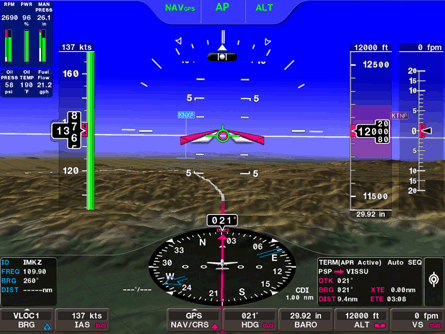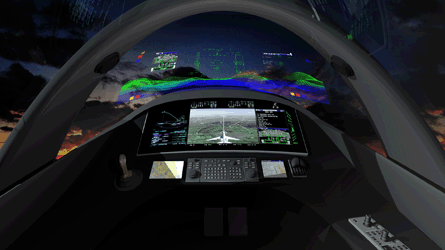Advances in consumer electronics and a relatively open-minded safety regulator are leading to a renaissance in flightdeck technology targeting the man-machine interface. In the next three-to-five years, advances by avionics makers on market-proven innovations will make cockpits more intuitive and user-friendly, to a point that seemed unimaginable 10 years ago.
Along with enhanced situational awareness and more intuitive symbology on the primary flight display (PFD), the man-machine interface is likely to include gesture-based touchscreen control, voice command and control, and full-immersion - or perhaps even 3D - displays. In many cases advances will be inter-linked with the consumer market.
 |
|---|
© Honeywell Honeywell has taken the lead on fused synthetic vision and infrared displays |
The idea of modern conveniences in the cockpit is a sea change from 10 years ago, when there were significant concerns over whether regulators would allow consumer electronics and gaming industry advances to take their place at the "business end" of an aircraft.
The change in attitude regarding certified aircraft started with synthetic vision approvals, first seen in the Part 23 arena. In 2002, Arizona-headquartered Universal Avionics gained approval for an exocentric (view from above and behind) synthetic vision (SV) view on a multifunction display. The following year, Texas-based Chelton Flight Systems earned a supplemental type certificate for its wireframe SV on the primary flight display. Universal made news again in 2005, with an egocentric SV system for the PFD in Part 25 aircraft.
Along with Garmin, in 2008 Gulfstream and Honeywell began offering their own versions of the technology for light aircraft and large cabin aircraft respectively.
In another progressive move, in 2001, the US Federal Aviation Association certified a Gulfstream and Kollsman enhanced flight vision system (EFVS) that included a forward-looking infrared camera and head-up display. The system gave infrared vision the same credit as natural vision down to a 100ft (30m) decision height on a Category 1 instrument approach that otherwise has a 200ft decision height.
Efforts continue at a growing number of airframers to create an advanced EFVS that will allow for a zero ceiling, zero decision height. There is also significant work being carried out on fused SV and infrared displays offering the best of both worlds, an area in which Honeywell has taken the lead.
Most, if not all, avionics makers are looking to offer an SV option as standard, including units for the lightest of light sport aircraft, and efforts are under way to gain reduced minimums on Category 1 instrument approaches with the equipment as a stand-alone aid. As SV is, by all accounts, an expected baseline element for any new panel, manufacturers are searching for the next man-machine interface product differentiators.
BURDEN OF PROOF
Universal Avionics fought many of the initial battles with the FAA to gain acceptance of the SV technology, paving the way for other manufacturers but ultimately slowing Universal with its own new product introductions. "There was a lot of resistance, particularly at the Part 25 directorate [at the FAA]," says Jim Brannen, director of software and systems engineering at Universal's instrument division in Georgia. "The burden of proof was definitely on us to show the merits of this approach on safety."
The FAA was adopting a conservative stance that had always paid off. "We're not killing people now, so you really have to make the case that this was better from a safety perspective," Brannen recalls of the regulator's initial impressions of what Universal was attempting. "One of their main concerns was that SV was sufficiently interesting to be distracting, taking attention away from something more serious."
 |
|---|
© CMC Esterline The SmartDeck integrated flightdeck |
The FAA hurdles ultimately proved surmountable, and Brannen says he thinks "everyone recognises the safety benefits [of SV] today". Universal, having caught up with other vendors with offerings such as runway renderings on screen, is pushing the boundaries again.
Universal is exploring next-generation technologies such as touchscreen interfaces, voice recognition and realism of SV scene. Brannen says Universal president and chief executive Ted Naimer, himself an avid Bombardier Challenger 601 pilot, is interested in voice recognition from the standpoint of tactical operations.
Brannen says the idea would be to use voice to initiate actions such as changes to a flight plan when the pilot gets cleared to another waypoint. "You don't have to take hands off of the control wheel and go delving into menus," says Brannen.
As for the PFD, Universal is also investigating leaps in the resolution and realism of the synthetic scene, perhaps bringing in satellite imagery. "There's going to be a debate over the practical merits of what's on the display versus what's out the window or what's on the charts," Brannen says.
"We're still having some of the same old arguments [with the FAA]. With the newer technology, in terms of processor power and memory, we can add even more realism to synthetic vision. But are we doing something for the sake of looking different or is it a benefit to the pilot?"
Integrated avionics manufacturer Esterline CMC looks at advances such as touchscreen as more mandate than choice. "The next generation of pilots will expect that in an aircraft," says Vincent Lorion, CMC's manager of advanced platforms and new technologies.
In 2010, the Montreal-based manufacturer entered the synthetic vision cockpit world by licensing L-3's SmartDeck integrated flightdeck technology, which it has now tailored. CMC says it plans to reveal two new Part 23 forward-fit applications for the flightdeck in the near future.
Research and evaluation efforts are under way for touchscreen interfaces on SmartDeck, as well as for voice recognition and other advanced man-machine technologies. "There's prototyping in the lab now, and then we'll go out and flight test [the technologies]," says Lorion.
Along with voice recognition, Lorion says CMC is evaluating "many" multi-input touchscreen technologies in the lab and is also prototyping methods or "getting more real estate" on the flightdeck with displays bigger than today's largest 38cm (15in) screens, possibly based on a series of connected smaller displays.
Another way CMC is working to simplify the flightdeck is to remove PFD "clutter". Lorion says the trend with integrated cockpits has been heading toward showing "too much information at all times", which can be confusing to a pilot. One option CMC is investigating is to display only information relevant to the particular phase of flight. Included is a dynamically-sized flight path marker - or "donut" - which will be larger for cruise flight and smaller for approaches, helping the pilot intuitively understand the required handling precision to remain on course.
TOUCH AND SWIPE
Lorion says voice recognition systems have potential, but issues have to be worked out. "We have [voice recognition] in cars, but it doesn't work well," he says. "Pilots cannot start remembering what the command for such-and-such is." Rather, Lorion says, the system must be as helpful as a "second or third pilot" in the cockpit. "It has to be very intuitive, quick."
In the summer, Rockwell Collins - whose SV-equipped Fusion integrated avionics suite will first enter service on the Gulfstream G280 early in 2012 - revealed its plans to certify the industry's first touchscreen PFD, for both forward-fit and retrofit applications.
First certified versions in the next two to three years are likely be "touch and swipe", which includes not only touching the screen to select an option (single touch), but dragging items around on the screen (for rerouting and other functions).
 |
|---|
© Rockwell Collins Rockwell Collins has revealed plans to certify the industry's first touchscreen PFD |
Rockwell Collins is looking into the technology as well. "We'll be going from single touch into gesture capability," says Paul Ekman, senior director of the company's head-down display centre of excellence.
Gestures, or multi-touch modes, include the "pinch and zoom" actions so familiar with Apple tablets. That technology, which uses projective capacitance (PCAP) methods, may not be applicable for aviation because of the danger of inadvertent commands. "In avionics, we're looking more at resistive touch right now," says Ekman.
Unlike PCAP, which reads the electromagnetic field created by the finder's proximity to the screen, PCAP depends on an actual deformation of the screen surface. Ekman says that while it takes a "more purposeful" touch and is "awkward" for multi-touch gesturing, it also allows the pilot to wear gloves or use a stylus. "It's better for rugged environments," he says.
Rockwell Collins' display centre is looking at ways to attain the best of both worlds by varying the thickness of the display glass and other options. "We've been able to modify the feel of resistive touch," Ekman says.
Another possibility with touchscreens is some kind of feedback - or "haptics" - to indicate a "positive event" has taken place. Unlike a cellphone, which can be set to vibrate when a touchscreen entry is made, an integrated flightdeck would need something different. "It's a bit of a challenge," says Ekman. "We have had discussions about pilot seats and audio feedback."
Source: Flight International























